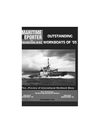
Page 9: of Maritime Reporter Magazine (November 1993)
Read this page in Pdf, Flash or Html5 edition of November 1993 Maritime Reporter Magazine
The President's Plan (Continued, from page 9) • Step 2: Adapt Naval Skills To
Commercial Applications: U.S. shipyards have invested heavily in modern facilities and technology.
Additionally, labor rates in U.S. yards are competitive, and U.S. shipyard workers are highly skilled.
However, U.S. yards have been building ships to order for the mili- tary requirements of the U.S. Navy and the sporadic demands of the
Jones Act fleet. At the same time, foreign yards have been building ships in series from standard de- signs optimized for producibility as well as functionality, thereby ben- efiting from scale economies and learning efficiencies. Although the steps required to adapt to the de- mands of this commercial market vary among U.S. shipyards, in gen- eral yards must: • Shorten the time required to de- velop a ship design in response to a specific demand by adopting mod- ern design procedures and develop- ing designs in advance of need; • Strengthen relationships with suppliers to reduce the time re- quired to procure materials and parts; and • Fully employ modern technolo- gies in the construction of ships including construction techniques such as modular construction, manufacturing processes, and pro- cess flow. The lay-out of at least some facilities may have to be re- vised to adopt these tools.
THE PLAN
Throughout the U.S., shipbuild- ers are focusing on the challenges of entering the international mar- ket for ocean-going vessels. Indi- vidually, yards are working to im- prove the technologies and produc- tion processes needed for building commercial ships. In addition, some yards have entered joint ventures or alliances with foreign yards to develop new designs and produe tion capabilities. The Administra- tion's plan is intended to assist in- dustry efforts to compete interna- tionally. Furthermore it is intend- ed to be a transitional program, consistent with federal assistance to other industries seeking to con- vert from defense to civilian mar- kets. The plan has five elements: ensuring fair international compe- tition, improving commercial com- petitiveness with MARITECH, eliminating unnecessary govern- ment regulations, assisting with the financing of ship sales, and assist- ing with marketing efforts.
Ensuring Fair International
Competition
The U.S. government is seeking to level the international playing field at the Organization for Eco- nomic and Cooperative Develop- ment (OECD). To this end, the
Administration initiated interna- tional negotiations to end foreign subsidies. U.S. negotiators believe that there is a reasonable chance that these negotiations will be suc- cessful. (November 1993 has been set as a target date for completion.)
The OECD draft agreement that is currently under negotiation is com- prehensive in its coverage. It pro- hibits direct and indirect subsidies to shipbuilders in the form of loans, grants, debt forgiveness, tax bene- fits, and research funding above de- fined limits. It also bans export credit financing programs with terms more generous than agreed interna- tional terms. ft
Official regulations and practices such as those that allow anti-com- petitive arrangements or impose domestic build requirements and other discriminatory regimes are forbidden (although the U.S. has proposed a derogation for the Jones
Act). The draft agreement also es- tablishes an injurious pricing disci- pline for ships, similar to anti-dump- ing laws which do not apply to ships.
Binding dispute settlement proce- dures are envisaged to enforce the agreement. A target date of Janu- ary 1, 1995 has been set for the elimination of subsidies and other distortive practices. While the Ad- ministration believes that a multi- lateral agreement provides the best way of dealing with the problem of foreign subsidies, it will work with
Congress on legislation to bolster those efforts. Any such legislation should provide for the investigation (Continued on page 12)
ABS has developed classification programs for virtually every type of workboat. We're authorized by more than 100 flag administrations to perform surveys and technical reviews and issue certificates of compliance.
In short, we can handle all your workboat classification needs.
ABS
HIGH TECH FOR THE HIGH SEAS
New York -212 839-5000 • Houston - 713 8/3-0700
Cleveland - 216 835-3900 • New Orleans - 504 523-5973
Singapore - 65 353-5713 • London - 44-71 247-3255
To help protect your interests and assist you with international business,
ABS classification is the answer.
For more information about our workboat classification services, contact your nearest ABS office.
Circle 200 on Reader Service Card
Is The Only Choice!
Sea Recovery has the right watermaker for you. From 200 to 25,000 U.S. gallons per day (750 to 95,000 liters per day), our reverse osmosis desalination systems provide you with fresh water on demand, under any sea or land condition. There's only one way to take on water...The Sea Recovery Way!
Call Toll Free l-(800)-354-2000 for our color brochure.
Aqua Frame 200-1500 gpd SRC 15m3-H 1300-4000 gpd Sea
Recovery "The Watermakers That Work!" fill
SRC 15m3-V i 1300-4000gpd
Telephone 1-310-327-4000
SRC 30m3 5300-8000 gpd SRC 95m3 10000-25000 gpd
P.O. Box 2560, Gardena, CA„ 90247-0560, U.S.A.
Fax 1-310-327-4350 • Telex 182598 SEARECOVE
Circle 293 on Reader Service Card
November, 1993 11

 8
8

 10
10
